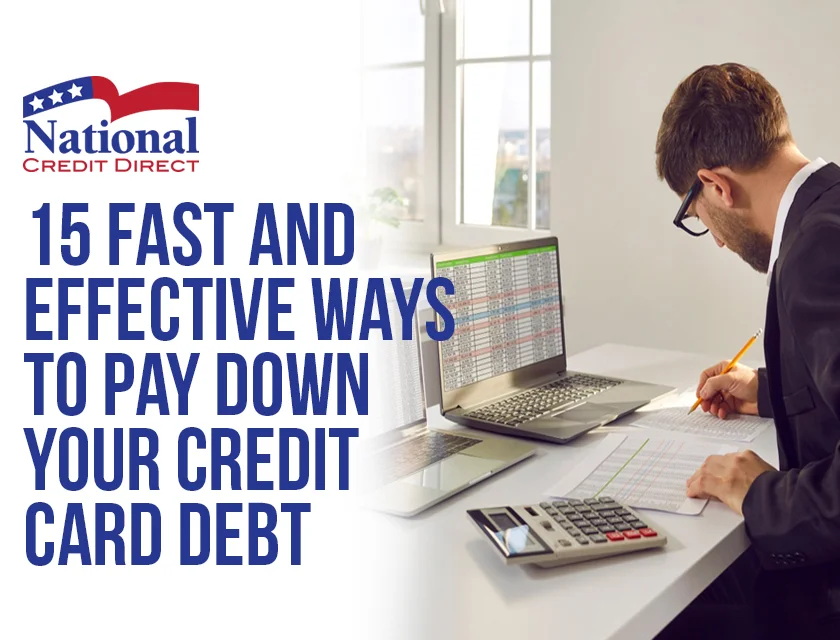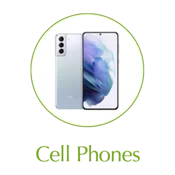15 Fast and Effective Ways to Pay Down Your Credit Card Debt

Why It Matters:
Carrying high credit card debt can reduce your credit score, restrict your financial freedom, lead to overwhelming interest payments, and cause long-term stress. Paying off this debt efficiently allows you to save money and regain control over your financial future.
With credit card interest rates frequently exceeding 20%, and balances adding up quickly, managing credit card debt can feel daunting. The good news? A strategic plan can make all the difference. Whether you prefer to focus on paying off high-interest debts, targeting small balances, or consolidating what you owe, there are proven methods to help you achieve your goals.
This article outlines 15 effective ways to pay down your credit card debt. From the avalanche and snowball methods to budget adjustments and income-boosting tactics, these strategies will empower you to tackle your debt with confidence.
Tip:
Start by gathering your credit card statements and identifying how much you owe. Understanding your total debt and interest rates will help you choose the best repayment strategy.
Table of Contents
- Avalanche Method: Targeting High-Interest Debt
- Snowball Method: Tackling the Smallest Balances
- Consolidate Debt: Simplify and Save on Interest
- Pay More Than the Minimum
- Budgeting: Gain Control of Your Finances
- Build an Emergency Fund: Avoid Future Debt
- Start Earning More Income: Accelerate Debt Repayment
- Switch to Cash for Daily Expenses
- Use Financial Windfalls to Pay Off Debt
- Consider Credit Counseling or Debt Management Plans
- Negotiate a Lower Interest Rate
- Use a Debt Payoff App
- Avoid Adding New Debt
- Consider a No-Spend Challenge
- Seek a Credit Card Hardship Program
- Conclusion
Avalanche Method: Targeting High-Interest Debt
Why It Matters:
Paying off high-interest credit card debt first saves you the most money in the long run by reducing the total interest paid over time.
The avalanche method focuses on paying off the credit card with the highest interest rate first, while continuing to make minimum payments on all other cards. This method is ideal for those who want to minimize the total amount of interest paid and are motivated by long-term savings.
Here’s how it works:
- List your credit cards by interest rate, starting with the highest.
- Make minimum payments on all cards except the one with the highest interest rate.
- Apply any extra funds to the card with the highest interest.
- Once the highest-interest card is paid off, move on to the card with the next highest rate.
By reducing your most expensive debts first, you’ll save the most on interest charges. While the avalanche method doesn’t provide the early "wins" that other methods do, it’s the most cost-effective way to tackle large balances with high-interest rates.
Tips:
Set up automatic payments on your highest-interest card to ensure you never miss a payment and maximize interest savings.
Snowball Method: Tackling the Smallest Balances
Why It Matters:
For many, staying motivated while paying off credit card debt can be a challenge. The snowball method helps maintain motivation by giving you quick wins early on.
The snowball method focuses on paying off your smallest balances first, regardless of the interest rates. It’s ideal for people who feel overwhelmed by multiple debts and need to see progress to stay committed to their repayment plan.
Here’s how it works:
- List your credit card balances from smallest to largest.
- Make minimum payments on all your cards, except the one with the smallest balance.
- Direct extra funds toward paying off your smallest debt.
- Once your smallest debt is paid off, roll that payment into the next smallest balance.
This method provides a psychological boost by eliminating small debts quickly, which can motivate you to keep going. While it might not save as much on interest compared to the avalanche method, it’s a powerful approach for those who need visible progress.
Tips:
Celebrate each time you eliminate a balance. This positive reinforcement keeps you motivated as you tackle larger debts.
Consolidate Debt: Simplify and Save on Interest
Why It Matters:
Debt consolidation can help you combine high-interest credit card debt into one manageable payment, often with a lower interest rate.
Debt consolidation involves merging multiple credit card balances into one new loan or credit card with a lower interest rate. This can help streamline your payments and reduce the overall interest you pay, making it easier to manage your debt. Common ways to consolidate include:
- Balance Transfer Credit Card: These cards offer a 0% introductory APR for a limited time, allowing you to transfer your existing high-interest credit card debt and pay it off without accruing new interest.
- Personal Loan: You can take out a personal loan with a lower interest rate than your credit cards to pay off your balances. This method simplifies your payments and may improve your credit score by reducing your credit utilization ratio.
Debt consolidation is particularly useful if you’re juggling multiple high-interest accounts and want to lower your overall interest cost while simplifying your repayment process.
Tips:
Before consolidating, make sure you calculate any fees associated with balance transfers or personal loans, such as origination fees or balance transfer fees, to ensure you're truly saving money.
Pay More Than the Minimum
Why It Matters:
Making only minimum payments on credit card debt means paying more interest over time and taking longer to become debt-free. Paying more than the minimum reduces the overall interest you owe and speeds up repayment.
Credit card companies typically set low minimum payments, which keep you in debt longer and cost you more in interest. If you're serious about paying off debt faster, consistently paying more than the minimum amount is crucial. For example, if you have a $5,000 balance with an interest rate of 20%, paying only the minimum could take over a decade to eliminate the debt, while paying extra could cut that time significantly.
Here’s how you can approach this:
- Review your credit card statements whenever possible. Even small amounts make a big difference in reducing the balance and interest charged.
- Increase payments for more than the minimum to ensure you're consistently paying down your balance faster.
Paying extra each month reduces your principal balance and lowers the amount of interest accrued, saving you money in the long run.
Tips:
Use any windfalls—such as tax refunds, bonuses, or unexpected income—to make larger payments toward your credit card debt.
Budgeting: Gain Control of Your Finances
Why It Matters:
Without a clear understanding of where your money is going, paying off credit card debt can be a struggle. A budget helps you prioritize debt repayment and make sure you're not overspending in other areas.
Creating and sticking to a budget is essential when tackling credit card debt. The goal is to ensure you have enough money to cover your essential expenses while setting aside extra funds to pay off debt. There are several budgeting methods you can use, including:
- 50/30/20 Rule: This method allocates 50% of your income to needs (e.g., housing, groceries), 30% to wants (e.g., entertainment), and 20% to savings or debt repayment.
- Zero-Based Budgeting: In this approach, every dollar is accounted for, with the goal of having no leftover money unassigned at the end of the month. This method can help you stay laser-focused on paying off debt by dedicating every extra dollar to it.
Budgeting not only helps you manage your current finances but also prevents you from adding more debt by highlighting unnecessary expenses that can be cut.
Tips:
Review your spending monthly to identify any areas where you can cut back and reallocate that money toward paying off credit card debt.
Build an Emergency Fund: Avoid Future Debt
Why It Matters:
Unexpected expenses can derail your efforts to pay off credit card debt and push you back into borrowing. An emergency fund acts as a financial cushion, helping you cover unexpected costs without relying on credit.
Building an emergency fund of at least 3-6 months of living expenses provides security when financial surprises arise, such as car repairs or medical bills. This prevents the need to use credit cards for emergencies, allowing you to stay focused on your debt repayment plan.
Here’s how to start building your emergency fund:
- Set a goal: Aim for at least three months of essential expenses, like rent, groceries, and utilities.
- Automate savings: Set up an automatic transfer into a separate high-yield savings account every month.
- Start small: Begin with any extra funds, like tax refunds or bonuses, and grow the fund gradually over time.
Having this safety net in place reduces financial stress and helps you avoid taking on new credit card debt when unexpected expenses come up.
Tips:
Set up a direct deposit into your emergency fund account from your paycheck to build savings without thinking about it.
Start Earning More Income: Accelerate Debt Repayment
Why It Matters:
Sometimes, cutting expenses isn't enough to make significant progress on your credit card debt. Increasing your income can provide the extra funds needed to pay off debt faster.
If you’re struggling to make more than the minimum payments on your credit card debt, finding ways to boost your income can make a huge difference. This might involve asking for a raise, picking up extra hours at work, or starting a side hustle. With the additional income, you can make larger payments on your debt and reduce the interest you pay over time.
Here are some common ways to increase your income:
- Freelance or Side Hustles: Use skills like writing, graphic design, or driving for rideshare services to earn extra money.
- Sell Unused Items: Declutter your home and sell things you no longer need to generate quick cash.
- Overtime or Bonuses: If available, take on additional hours or projects at work for extra income.
By putting any extra earnings toward your credit card debt, you can pay off balances more quickly and avoid long-term interest charges.
Tips:
Use all additional income from side jobs, bonuses, or sales toward your credit card debt to accelerate repayment.
Switch to Cash for Daily Expenses
Why It Matters:
Using credit cards for everyday purchases can lead to impulse spending and more debt. Switching to cash helps you control your spending and avoid adding to your credit card balances.
Paying with cash makes transactions more tangible, helping you be more mindful of your spending habits. Once the cash in your wallet is gone, you can’t spend more until your next paycheck, which forces you to stay within budget. This approach can be particularly helpful when you’re focused on paying off credit card debt, as it prevents you from accumulating more debt.
Here’s how to switch to a cash-based system:
- Withdraw a set amount of cash at the start of each week for groceries, entertainment, and other daily expenses.
- Use only that cash for discretionary spending and avoid reaching for your credit card.
- Track your cash spending to understand where your money goes and find areas where you can cut back.
By switching to cash, you limit your spending and avoid adding to your credit card balances while focusing on paying down your existing debt.
Tips:
Leave your credit cards at home to avoid temptation and rely on cash or debit for purchases.
Use Financial Windfalls to Pay Off Debt
Why It Matters:
Unexpected financial windfalls, like tax refunds or bonuses, are great opportunities to make large payments on your credit card debt. Applying these windfalls directly to your balances helps reduce debt faster without affecting your regular budget.
When you receive an influx of cash, such as a raise, work bonus, or even birthday money, it can be tempting to spend it. However, using these windfalls to pay off your debt will help you make substantial progress in reducing balances, saving you money on interest in the long run.
Here’s how to use financial windfalls effectively:
- Commit to allocating all or a portion of unexpected income toward your debt.
- Make lump-sum payments on your highest-interest credit card or apply it to the next debt in your repayment plan (avalanche or snowball).
- Avoid lifestyle inflation, which means keeping your expenses consistent even after receiving extra funds.
Using windfalls in this way helps you pay off debt more quickly without having to cut back on your regular spending habits.
Tips:
Every time you receive a financial windfall, immediately apply it to your credit card debt before you’re tempted to spend it elsewhere.
Consider Credit Counseling or Debt Management Plans
Why It Matters:
If you’re overwhelmed by credit card debt, credit counseling and debt management plans can provide professional help, guiding you through structured repayment options and negotiations with creditors.
Credit counseling offers guidance on managing your finances and can help you create a plan to pay off your credit card debt. A debt management plan (DMP) involves working with a credit counselor to negotiate lower interest rates or payment terms with your creditors. This option is beneficial if you’re struggling to make payments and need help organizing your debt repayment.
Here’s how credit counseling and DMPs work:
- Meet with a certified credit counselor to discuss your financial situation.
- Develop a customized plan to pay off your debt over a specific period (typically 3-5 years).
- Negotiate with creditors to potentially lower interest rates or monthly payments.
- Make one monthly payment to the credit counseling agency, which distributes the funds to your creditors.
While enrolled in a DMP, you may be required to avoid opening new lines of credit, but the long-term benefit is a structured path to becoming debt-free.
Tips:
Before committing to a debt management plan, ensure the credit counseling agency is accredited by reputable organizations like the National Foundation for Credit Counseling (NFCC).
Negotiate a Lower Interest Rate
Why It Matters:
A lower interest rate reduces the amount of interest you pay each month, allowing more of your payment to go toward reducing the principal balance.
Credit card companies want to keep good customers, and if you’ve been making your payments on time, you may have more leverage than you think. Simply calling your credit card issuer and asking for a lower interest rate can result in substantial savings. Even a 1% to 2% reduction can make a big difference, especially on high balances. This is especially effective if your credit score has improved since you opened the account.
Here’s how to do it:
- Prepare your case: Before you call, review your payment history and credit score to demonstrate that you're a reliable customer.
- Make the call: Contact your credit card issuer and politely ask if they can lower your APR.
- Negotiate: If the first representative says no, ask to speak with someone who might have more authority. Persistence often pays off.
By reducing your interest rate, you can make faster progress on your debt repayment with the same monthly payments.
Tips:
Use your improved credit score as leverage when negotiating. Highlight your positive payment history and ask for a specific reduction in interest rates.
Use a Debt Payoff App
Why It Matters:
Debt payoff apps help automate your debt repayment process and provide visual progress tracking, which can keep you motivated.
Technology can be a great ally in your debt repayment journey. Debt payoff apps like Tally, Mint, or Undebt.it help you track payments, organize your debts, and even automate the process of paying them off. Some apps offer customized repayment schedules based on the avalanche or snowball methods, giving you a clear picture of how long it will take to become debt-free.
Here’s how to do it:
- Track your progress: These apps provide a visual representation of your debt repayment journey, helping you see how each payment reduces your total debt.
- Set goals and reminders: The apps help you stay on track by sending reminders and helping you set achievable goals.
- Automate payments: Some apps even allow you to automate extra payments toward specific debts, streamlining the process.
Using an app ensures that you’re organized and making steady progress toward eliminating your debt.
Tips:
Choose an app that aligns with your preferred debt repayment strategy, whether it’s the avalanche or snowball method, to ensure it supports your financial goals.
Avoid Adding New Debt
Why It Matters:
Continuing to use your credit cards while paying off debt will undermine your progress. Sticking to cash or debit prevents further debt accumulation.
The biggest obstacle to paying off debt is often adding more debt. While you're working on repaying existing balances, it’s essential to avoid using your credit cards for new purchases. Leave your cards at home or even freeze them in a literal block of ice as a visual deterrent to impulse spending.
Here’s how to do it:
- Switch to cash or debit: For daily purchases, use cash or a debit card to avoid accumulating new credit card balances.
- Set a strict budget: Make sure you're sticking to the budget you created earlier, allocating funds for all necessary expenses without relying on credit.
- Avoid online shopping: Online shopping makes it easy to spend impulsively. Remove stored card information from websites to reduce temptation.
By focusing solely on paying down existing debt, you’ll make faster progress without adding more financial strain.
Tips:
Store your credit cards in a hard-to-reach place to reduce the temptation of using them for unnecessary purchases.
Consider a No-Spend Challenge
Why It Matters:
A no-spend challenge frees up extra money for debt repayment by temporarily cutting out non-essential expenses.
A no-spend challenge involves committing to a period where you don't spend money on anything beyond essentials like food, housing, and utilities. This can be a powerful tool for freeing up extra cash that can go straight toward paying off your credit card debt.
Here’s how to do it:
- Set a time frame: Decide whether your no-spend challenge will last for a week, month, or longer.
- Identify essentials vs. non-essentials: Cut out non-essential spending such as dining out, entertainment, or new clothes.
- Redirect savings to debt: Take the money you would have spent on non-essentials and put it directly toward paying down your credit card debt.
By limiting your spending for a set period, you can significantly accelerate your debt payoff plan while developing better long-term financial habits.
Tips:
Set a specific debt repayment goal for the no-spend challenge, such as paying off a particular balance by the end of the challenge.
Seek a Credit Card Hardship Program
Why It Matters:
Credit card hardship programs offer temporary relief in the form of lower interest rates or payment plans, making it easier to manage your debt.
Many credit card companies offer hardship programs for customers facing financial difficulties, such as job loss or medical emergencies. These programs can temporarily reduce your interest rates, waive fees, or set up a more manageable repayment plan, allowing you to focus on paying down your debt without added financial stress.
Here’s how to do it:
- Contact your issuer: Explain your financial situation to your credit card issuer and ask if they offer a hardship program.
- Negotiate terms: Be prepared to discuss your income, expenses, and the challenges you're facing. Credit card companies are often willing to work with you if they know you’re committed to repayment.
- Stick to the plan: Once you're enrolled in a hardship program, make sure to follow through with your payments as agreed.
A hardship program can provide breathing room to manage your finances, allowing you to focus on becoming debt-free.
Tips:
If you’re considering a hardship program, make sure to ask about how participation will affect your credit score and if there are any fees involved.
Conclusion
With these additional strategies—negotiating lower interest rates, leveraging debt payoff apps, avoiding new debt, taking on a no-spend challenge, and enrolling in credit card hardship programs—you now have 15 powerful ways to pay down your credit card debt. Implementing even a few of these strategies can help you take control of your finances and work toward becoming debt-free faster.
^ We will issue you 35,000 Bonus Points with your paid purchase. The Smart TV is a 24" TV with apps for watching streaming videos. You may also use these Points for this or any other item we offer at our Reward Points Redemption Center. * According to Account terms. Certain restrictions apply.




























